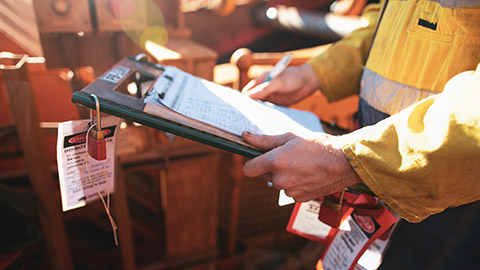For each building and construction project, you should break the project into its component tasks. This means that you should break the project down into discrete, measurable tasks.
A typical construction task might include:
- Reading and interpreting plans, specs, work orders/instructions
- Reading and applying safe work method statements
- Inspecting the work site to assess the scope of work
- Inspecting the worksite to assess hazards (environmental and safety) and implement risk controls
- Confirming existing services have been disconnected/made safe
- Installing signs and barriers
- Identifying and reporting hazardous materials
- Moving materials, tools and equipment to the site or work area
- Manufacturing components
- Setting out
- Levelling
- Assembling components
- Erecting/installing the project
- Removing materials to storage
- Removing materials to the disposal area
- Cleaning up
- Checking, maintaining and storing tools and equipment.
For each component task, you can then identify:
- What needs to be done
- How you will do it
- The plant, tools and equipment required (including PPE)
- The materials that you will require
- You will need to meet the relevant laws and regulations/Australian Standards and workplace policies and procedures
- How long you estimate it will take
- How many people will be required for the task?
- The WHS considerations (hazards and controls)
- The environmental considerations (hazards and controls).
How does a process help?
Using this process helps you keep control of the project and ensure that you have everything you need before getting started.
You can also use the information from this list to prioritise the work and develop a workflow plan. A workflow plan places the tasks into a logical sequence which ensures efficient use of resources as well as helps to ensure safety.
The following is an example of what you will need to include to complete the components task template.
| Project title: | |
|---|---|
| Provide a brief description of the project. | Use the plans, specifications, drawings and other supporting documents to describe the project. Your description only needs to be one or two sentences. |
Provide a summary of the information that you got from the plans, drawings and specifications, work orders/ instructions, SWMS and other supporting documents under the following headings:
|
Potential work health and safety issues: Your list of potential WHS issues should reflect those listed in the SWMS and any that you identify in the plans, specs and supporting documents. They could include things like:
|
Potential environmental issues: Your list of potential environmental issues should reflect those listed in the environmental management plan and any you identify in the plans, specs and supporting documents. They could include things like:
|
|
Component tasks
Use the table below to break the project into its component tasks. For each component task, describe:
- what needs to be done.
- how you will do it
- the plant, tools and equipment required (including PPE)
- the materials that you will require
- the relevant laws and regulations/Australian Standards/Codes of Practice and workplace policies and procedures
- how long you estimate each component task to take
- the WHS considerations (hazards and controls)
- the environmental considerations (hazards and controls).
| Component task 1: | Describe the component task here. Each component task should be a discrete, measurable task. Tasks should be consistent with supplied plans, specifications, drawings, SWMS/JSEA and other supporting documents. Tasks could include things like:
|
|---|---|
| What needs to be done? | Describe what needs to be done to complete this component task here. |
| How will it be done? | Describe how you will complete the component task. |
Tools and equipment
Tools and equipment What tools and equipment are required? Describe the tools and equipment that you will require for this stage of the project. What will you use each one for? How will you check it for serviceability? Don’t forget to include PPE.
| Tool/equipment (include PPE) | Use | Serviceability | |
|---|---|---|---|
| Safety boots | PPE | Properly fitted, correct size, comfortable to wear, not damaged | |
| Safety hat | PPE | Properly fitted. Correct size, comfortable to wear, not damaged | |
| Hi-Vis clothing | PPE | Properly fitted | |
| Safety glasses | PPE | Ensure they are not damaged | |
| Sunscreen | PPE | Check expiry on sunscreen | |
| Hammer | Hand Tool | Check to ensure the handle is not damaged | |
| Drills | Power Tool | In working order and, if the cordless drill is charged | |
| Retractable tape measure | Hand Tool | All measurements are visible | |
| Spirit level | Hand tool | No cracks | |
| Nail Gun | Power tool | In working order and electrical wires are away from water | |
| Air compressor and hose | Power tool | In working order and electrical wires are away from water. | |
| What materials will you need for this component of the task? You can use this information to build a component list for the whole project. | Materials should include everything required for this component of the overall task. You can rely on the plans, specifications and work instructions for this information. | ||
| Estimate how long this component of the overall construction project will take. | How many hours, days, weeks, or months is this component going to take. | ||
| How many people will you need to complete this task? | Please include any special skills, knowledge, licenses or expertise that they will require. | ||
Laws and regulations
List the relevant laws and regulation, NCC areas, Australian Standards and workplace policies and procedures that apply to this component of the building and construction project. You may like to add notes to yourself about how you will take these things into account.
| Law/regulation/NCC/AS/policy/procedure | How I will take these into account for this component task. |
|---|---|
Laws and Regulations may include:
|
Check the task against each relevant law and regulation. |
Australian Standards may include:
|
Check the task against each relevant Australian Standard. |
NCC requirements may include:
|
|
Policies and procedures may include:
|
Describe the WHS considerations for this component of the construction task (hazards and controls).
| Hazard | Controls |
|---|---|
| Materials falling from heights | Secure any panels of wood, framing. Familiarise yourself with the first aid trained personnel on-site. |
| Untidy worksite with tools, materials left in the way of workers causing a potential trip hazard | Keep worksite tidy, do not leave tools and materials where they cause a trip. |
| Asbestos | Ensure workers have been properly trained on asbestos removal and have all the appropriate PPE. Or consult with relevant team members who have the experience, knowledge and training to do so. |
Describe the environmental considerations/hazards for this component of the project (hazards and controls).
| Environmental consideration/hazard | Controls |
|---|---|
| Extreme weather, wind, rain, thunderstorms | Avoid work on heights, do not use electrical tools. If the weather is too dangerous, postpone work on the site until the weather is no longer a hazard. Familiarise yourself with the first aid officer on site. |
| Sustainability | Where possible, ensure offcuts or materials such as wood has been disposed of in a sustainable manner or, where possible, reused for an alternate purpose. |
| Sun exposure/heat | Ensure workers are hydrated and have sunscreen and appropriate clothing for extreme heat. (PPE) Familiarise yourself with the first aid officer on site. |
Estimating timeframes
Estimating how long each component task of a project can be tricky, especially when gaining experience. Time is very unpredictable, so it is important to remain organised, focus on the task and familiarise yourself with the constraints. The type of task or project you complete will cause variations in the time spent completing them. However, there are some techniques that you can use to help.
For example:
- Use the work order and work instructions to guide you.
- Take the initiative, and ask more experienced colleagues.
- Research industry benchmarks.
- Break down tasks and make an estimate of how long each element will take – add a buffer for unforeseen circumstances of at least 15 per cent.
- History – look back over previous jobs and work out how much time similar tasks took you.
How many people will you need to complete the task?
Estimating how long each component task of a project can be tricky, especially when gaining experience. Time is very unpredictable, so it is important to remain organised, focus on the task and familiarise yourself with the constraints. The type of task or project you complete will cause variations in the time spent completing them. However, there are some techniques that you can use to help:
- use the work order and work instructions to guide you
- think about the manual tasks involved – do you need additional people for lifting, supporting structures etc
- do you need people with skills/licences/equipment that you don’t have
- ask more experienced colleagues
- research industry benchmarks
- history – look back over previous jobs and work out how many people you needed for similar tasks.

There are many techniques that you can use to help generate ideas and get you thinking about all of the components of a particular project. Take a short break from the reading and watch the following video with valuable information about workflow planning. The video breaks down each process and offers a range of suggestions and information ranging from the risks present from the start to finish of the project to sustainability, how to keep the consumer happy, what to consider in your workflow plan, and why they are important.
Breaking down the techniques
Now that you have developed a deeper understanding of workflow planning techniques, you will now learn how to put the theory into practice.
Once you have broken the project down into its component tasks and analysed each of them, you can use that information to develop a workflow plan. The workflow plan provides you with a road map for the project. It should place each task into a logical sequence that maximises efficiency.
When developing a workflow plan, consider the following:
- Access to tools, resources and equipment: Is there speciality equipment that is already being hired? Are there resources that are at risk of being over-utilised on a particular day? Would your use of equipment create a noise hazard if used simultaneously as someone else on-site?
- Access to trades already on-site: Is there a speciality trade on site on a particular day that you need access to? Can you maximise efficiency?
- Safety issues: Are there risks associated with too many people on-site at a particular time?
- Efficiency and quality: How can the flow of work be structured to maximise efficiency and quality?
Use the information from the analysis that you did in Part A to develop a workflow plan. Ensure that each component task is sequenced in a logical order to maximise the efficiency of the use of resources.
| Component task (ensure that tasks are listed in a logical order) |
|---|
| You may like to include a brief explanation for why you placed each component task in a particular order as a reminder to yourself. For example, a project is at the stage of building a timber frame for a single-story house. |
| 1. Clear and establish the site |
| 2. Set Out |
| 3. Excavation of footings |
| 4. Plumber |
| 5. Termite treatment |
| 6. Pouring of concrete |
| 7. Wall frame |
| 8. Windows and external doorframes and external cladding |
| 9. Roof trusses |
| 10. Roof and guttering |
| 11. Internal linings |
| 12. Fit-out and cabinetry |
| 13. Clean |
* Add additional rows to this table if required.

Another important stage in the planning and organising process is to develop a components list. The components list is a list of everything that you need for the project and the quantities. A components list template can be viewed here.
The following is a sample template on how to develop a components list. Calculate the quantities of each of the materials that you will require (you will learn more about calculating quantities of materials in other units).
| Material | For use in component tasks | Quantity required |
|---|---|---|
| List the materials in this column | List the component tasks that each material will be used in here so that you will know when you will need them. | List the total quantity required so that you know how much to obtain/order |
| 1. | ||
| 2. | ||
| 3. | ||
| 4. | ||
| 5. | ||
| 6. |
* Add additional rows to this table if required.
For some tasks, before you begin work, you will need to inspect the site where the work will take place. This also becomes a part of planning and estimating time. Each site will vary. Therefore the amount of time you spend on inspecting the site will need to be considered. Site inspections are important and are facilitated for some of the following reasons. You will need to:
- ensure the site matches what you have seen in the plans and specs
- check that new hazards haven’t emerged (for example, damage caused by bad weather)
- ensure services have been properly identified, marked and disconnected or isolated
- erect signs and barriers
- identify power sources
- confirm environmental requirements and identify any new environmental issues.
Once the site inspection has taken place, you can then use the information you have obtained to help you update your workflow plan, clarify any discrepancies, and update your planning and preparation work.
Use this simple checklist when inspecting the worksite:
| No. | Checks | Complete? |
|---|---|---|
| 1 | Using a safe, systematic approach? | Y / N |
| 2 | Are you wearing the appropriate PPE? | Y / N |
| 3 | Have you orientated the site on the plan? | Y / N |
| 4 | Have you located key services on the site plan? | Y / N |
| 5 | Have you confirmed the plans you are working from are current? | Y / N |
| 6 | Have you confirmed the SWMS are current and accurately reflects the conditions on-site? | Y / N |
Finding discrepancies
What should you do if you find a discrepancy between the plans and specs, SWMS or any other document and your site inspection?
Your first step is to check your workplace policies and procedures; they will show you how to report the discrepancy.
This may be:
- in writing (email, prescribed form, marking up the documents)
- in person
- by phone
- electronically (webform etc.)
- by text
Ensure that the discrepancy is clarified and addressed before you start work.

